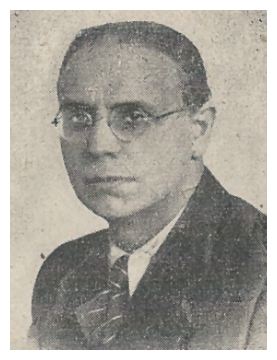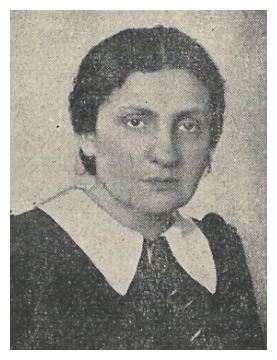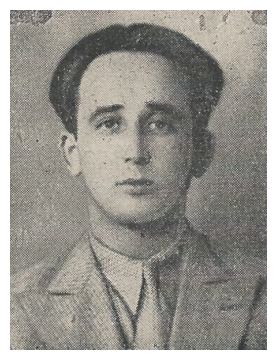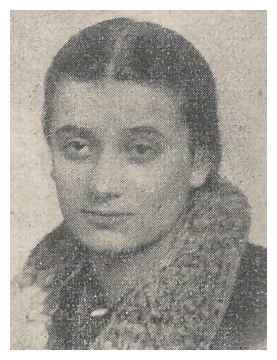 |
 |
 |
 |
|
Czenstochow was one of the few cities in Poland where a significant number of
political activists of all beliefs remained after the outbreak of the war. It
did not take long and the working activists began to organize underground
activities that drew in not only party members, but also many nonpartisans and,
chiefly, the young people.
During the early period the parties carried out their work separately. The
activity by the communists was made particularly difficult because of the net
that agents of the former Polish secret police began to spread over the
communist workers who were watched by them during the days of the Sanacja
[political movement founded by followers of Józef Piłsudski]. The
first communist victim was Leyzer Silman. Silman was known in the Jewish labor
circles under the name “Gandhi.” Silman survived many years in the
Sanacja jail and then in the Bereze [Kartuska] camp for his communist
activities. He was active again when he left Bereze Kartuska. On the first day
of September 1939 he was arrested and sent away to a German concentration camp.
[Page 59]
Many communist workers were forced to hide for a certain time and then leave
Czenstochow because of the net that was spread around them. Leibish Frank, the
well-known communist engineer, among others had to do the same thing.
Yet, despite the frightening terror, the communists organized. The pioneers of the renewed communist activity in the underground were: the old members of the S.D.K.P.L. [Social Democracy of the Kingdom of Poland and Lithuania – Marxist party]. Maks Opatowski, the former secretary of the Czenstochower Tailor Workers Union, as well as the tailor worker Srul Dreksler, the painter worker Yankl Wajnrib and A. Sztajnbrecher – all old communists. Many others joined with them. At the beginning of 1942, they made contact with the newly emerging Polish Workers' Party (P.P.R.) through Imialek, the Polish communist and joined in spreading the [party] obligations – dar narodowy [national gift] – to collect money for the purpose of carrying out an active struggle against the occupier.
The Bundists also joined the activity early. The first task was to burn the archive. During the burning, a fire broke out in the premises at Piłsudski Street 17. It did not take long and the premises were in flames. The firemen and the Germans appeared who extinguished the flames, but no trace of the archives remained.
During the month of November 1939, a group of Bundists, Futurists and Skifistn [members of the Socialistishe Kinder Farband – Socialist Children's Union] gathered at the Jewish cemetery, divided themselves into smaller groups and decided that a party committee should lead the conspiratorial work. A member of the party committee was placed at the head of that particular group. The second and the last large meeting of the Bundists took place in the same location in February 1940 (the first meeting took place during the burial of Michal Szimkowicz, the tragic utopian fatality and the second during the burial of the old Bundist, Moshe-Leibe Szimkowicz, the tailor worker who died a natural death). Among other things it was decided at the second meeting to smuggle the large Culture League library at Aleje 20 to Nadrzeczna Street 24 to Rayzela Berkensztat, the librarian, and to begin an illegal library there. This plan was carried out over the course of two days and the library began to serve hundreds of readers and, later, the dramatic circle as well.
In June 1940, the Gestapo intensified its search for worker activists according
to a list that the Gestapo had demanded that it receive from the Judenrat.
[Page 60]
At night on the 30th of April, the Gestapo and gendarmes spread out through the
streets of the ghetto with a precise list of communist workers and carried out
a large number of arrests. Dozens of communists were arrested then along with
their family members. Family members were taken when those searched for were
not found. In the morning, all of the arrestees were sent away to Auschwitz,
from which no one returned. Among those who perished then were: several from
the well-known Dzalowski family, the father of Meir Tenenbaum (Meir Tenenbaum
was jailed for communist activity for many years. He fought in Czenstochow
under the name “Majorek.” He perished in Warsaw, where he was hidden
with “Aryan” papers). Polya Tenenbaum, the communist youth worker and
active coworker from the MOPR [Miedzynarodowa Organizacja Pomocy Rewolcjonistom
– International Organization for Help to the Revolutionaries] (her father
and step-mother who “dared” to ask for her during the arrest also
were taken en route and never returned), Yitzhak Czanszinski, the democratic
worker, Grunem Frank (an uncle of the communist worker, Leibush Frank), with
whom Leibush Frank had hidden. The worker-activist, Yitzhak Opatszinki (he left
prison before the war after serving a sentence for communist activity), and a
group of communists and their closest family members as well as Czanszinksi,
the former council member from the left Paolei Zion [Marxist Zionists].
From time to time intra-party conferences took place to coordinate the underground activity. Two such conferences took place in 1940: one in the house of Machzikei haDas [Supporters of the Law] on Nadrzeczna Street and the second in the premises of TOZ at Berka Joselewicza Street 3. A second party conference took place during the month of August 1941 in the garden of the former Y. L. Peretz School at Krotka Street number 22 at which the question of creating a joint organization that would have a military character was considered. No agreement was reached in this area.
The activity of the Bund in the month of July 1941 was interrupted for a certain time because of the failure of the courier from the central committee in Warsaw, Marya Szczensna, to provide instructions and literature to the Bundist organization of the entire Radom district. Szczensna was arrested at the Piotroków train station during the first half of July 1941. [A large number of] arrests were made in connection with this. Among the arrestees was Motek Kusznir, who escaped. Five young people were arrested on the spot as hostages until Motek would himself appear or until the Judenrat turned him in.
|
|
|||
| Yitzhak Czonszinski | Rayzl Berkensztat | |||
|
|
|||
| Yitzhak Opoczinski | Polya Tenenbaum |
On the same day, Motek put himself at the disposal of the party committee,
which decreed that he should leave Czenstochow very quickly. At the same time
the Judenrat informed [the committee] that the Gestapo demanded that it turn
over Motek. If not, all of the hostages would be shot. A second meeting of the
Bundist party committee took place in the residence of the Rozine family at
Warszawa no. 8. Motek, himself, also took part in these discussions. His wife,
Rywka waited outside for the decision that would decide about life or death for
the one closest to her. It was discussed at the deliberations, whether they
should turn over an active worker to save the lives of others. There also was
the question whether the committee had the right to have the life of a comrade
at its disposal, whether the Gestapo would keep its word when it already had
its demanded victim [in its possession]. All made an effort and no one dared to
quickly give their thoughts; they felt guilty both in regard to who was sitting
here and with regard to whose lives were now in the hands of the Gestapo. Motek
declared that he was ready to appear at the Gestapo to keep the hostages alive.
Everyone who took part in these deliberations assured him that everything would
be done to rescue him from the murderers' hands. They felt that a serious error
would be committed, that this was a false and detrimental decision. Motek left
the meeting. His wife and comrades followed him from a distance. Motek walked
slowly, stopped for a second as if he was having a discussion with himself,
looked around, walked quickly for a few steps as if he were running and again
began to walk slowly in the direction of Kilinski Street. The Gestapo was
located there; it was rare for someone to come back from there. On the same
day, the Gestapo took Motek to the prison on Zawodzie and the hostages were
freed the next day. Every morning Motek was taken with the couple, Moshe and
Rayzele Berkensztat in a Gestapo vehicle from the prison to the Gestapo for a
“hearing” that lasted the entire day and at night they were led back
into the prison.
[Page 62]
Meanwhile, the Judenrat announced new demands by the Gestapo, that the old
Alerbardi, a Bundist, the grandfather of a communist activist, must be turned
over. Ten Jews would be shot if the demand was not fulfilled. A meeting of the
Bundist party committee took place in the room of Machzikei haDas [Supporters
of the Law]. Alerbardi, himself, took part in the consultations. Everyone was
silent. Alerbardi was silent, too. A heavy burden oppressed them: what should
they do? Who could know for how long the Gestapo would pull the chain of the
victims with blackmail? Who knew how long the Gestapo would blackmail them with
collective responsibility? The consultations lasted for many hours; everyone
understood that the earlier agreement that Motek would appear was a grave error
and it was decided no longer to repeat such a tragic mistake. Alebardi was sent
away to Radomsk and from there he left on foot for Piotrków, from where
comrades sent him to Warsaw where it was arranged for him to work in a people's
kitchen. Fensterblau, whom the Radom Gestapo were searching for in Czenstochow,
also left his hiding place and escaped to Warsaw.
The Berkensztat couple and Motek would be whipped all day with clubs and small
whips until they would faint. Then pails of water would be poured over them and
the “investigation” would begin again. The day of pain ended for the
men with them being lain down tied up with their heads under a water pipe
faucet so that every few seconds a drop of water would drip on their heads. The
torturing would end the “ investigation” for Rayzele with her breasts
clamped as in a vise with the doors of a closet. After such “interrogations,”
all three lay broken, sick and without moving in their prison cells for approximately
two weeks. During these two weeks, the Polish teacher, who had earlier gone
through the same thing and was now waiting in their ranks to be sent to
Auschwitz, took care of them. This teacher did everything he could that was
in his power as an arrestee to revive the strength of these three flogged people.
Meanwhile, there was success in bribing two political division members of the
Gestapo, Otto and Zeier, who were searching for Hershl Prozer. Each of
them received one pair of new boots, two suits and clothing for their children.
Hershl was taken to the Gestapo where he only received blows and after he was
thrown out as a “stupid Jew.” Leib Kusznir again bribed a member
of the Gestapo, Willy Krebs, through which in a certain manner (through
sending in food packages) they maintained contact with the arrestees and
encouraged them.
[Page 63]
Nine weeks later they succeeded in bribing the then consultant for political
matters at the Gestapo with 35,000 gildn in money and with valuable items and
they got Motek out of prison (the Birncwajg brothers helped gather the first
sum of money). At the Gestapo, Motek was considered as having been shot
according to its sentence and in Czenstochow Motek lived using the name
“Pulkowski.” After this case, we proceeded to rescue the Berkensztats
in the same way. However, we only succeeded in rescuing Rayzele Berkensztat.
Moshe Berkensztat, who had already been terribly tortured, was entirely swollen
with [damaged] kidneys; he was sent to Auschwitz from which his children
received a telegram that he had died and the Gestapo informed them that they
could have the ashes of his body sent to them for a certain payment.
The underground work by groups with all political leanings started separately
at the beginning of 1942 began to be carried out jointly. However, the
situation in the ghetto kept getting worse. New edicts kept coming, each one
more severe than the other. Sad news from other ghettos sneaked in; it felt
obvious that Czenstochow also would not avoid the terrible misfortune that had
already occurred in other Jewish settlements. Contact with Warsaw was rare.
There only was success in staying in contact with Warsaw through a young Pole
from the Warsaw Polish Underground movement who ordered detonators for
grenades. The detonators were ordered from the Slomnicki brothers, who had
organized a well-hidden mechanical workshop at Garibaldi Street, no. 11. During
one of his visits this messenger brought with him only a short letter written
in Yiddish that we should listen to him attentively and adjust to his
instructions. He met with us at the TOZ premises at the New Market no. 2. He
described to us in detail the destruction of the Warsaw ghetto and ended that
the ghetto there looked as if after a terrible plague. He carefully said that
Czenstochow would not avoid this and advised that we prepare for an open fight.
The same [messenger] also gave us the addresses of the designated places in
Warsaw to which we had to report if we had to escape from Czenstochow.
Meanwhile, an order was issued that all the Jews must pay the taxes owed from
years past by the 16th of September. Jews began to understand that the Germans
were in a rush to collect the taxes before any expulsion began. The legend that
Czenstochow would avoid the misfortune evaporated.
[Page 64]
The Jews from the small shtetlech [towns] that surrounded Czenstochow were sent
to Radomsk and then to Czenstochow. This was a clear notice to everyone that
the Germans were concentrating the Jews at several locations. The apprehension
and the unease spread even further. The underground workers intensified their
attention and began to seek means and ways to prepare for every eventuality. At
the beginning of September 1942 we learned that the city chief demanded of the
Judenrat a precise plan for the ghetto according to housing blocks. Several
days later we again learned about some kind of secret conference with General
[Julian Rudolf] Boettcher from Radom and several prominent men in Czenstochow,
which was concerned with Jewish matters. It was clear to us that the plan for
the ghetto was called for in connection with Boettcher's visit. It already was
clear to us that Boettcher, Barneman, Einrich and Blume, who held the
consultations, were preparing a plan of expulsion according to the instructions
that Boettcher gave them. The liaison-men from the underground groups decided
to call a joint conference to build a fighting organization. This conference
was designated for Yom Kippur, the 21st of September. The place where the
conference was supposed to take place was the premises of TOZ at the New Market
no. 2. Sumek Abramowicz and two comrades (communists), whose names were not
given, Brener and Kusznir (Bundists), Yisroel Szimanowicz (left Poalei-Zion
[Marxist-Zionists]), Rywka Glanc (kibbutzim [collective communities]), Yakov
Razine, Doctor Walberg, Doctor Mering and Uzer Berish Blechsztajn were supposed
to take part. They also waited for a representative from the Warsaw ZOB
[Zydowska Organizacja Bojowa – Jewish Fighting Organization]. The first
delegates, who were supposed to open the premises, Brener and Razine, were
stopped in the courtyard in front of the premises by security policemen at 10
'clock in the morning on Yom Kippur. They were beaten. They were freed after
about two hours, thanks to the intervention of the Jewish drivers who did
business with these German policemen. Alas, the already too late designated
conference did not take place and the expulsion-action that began on the same
night of the 21st to the 22nd of September 1942
lasted for five weeks and was carried out with inconceivable cruelty, not
encountering any organized resistance. The very intensive underground
activity that was going to be transformed into an active resistance movement
did not succeed in establishing its cadres. The greatest number of those who
were drawn into this work perished in Treblinka with the majority of the Jews
from the large Czenstochower community.
[Page 65]
Only a few of them had the luck of taking part in the Treblinka revolt, such
as: Wilinger, Lubling and so on. Among the most important organizers of the
Treblinka revolt was Moshe Langner, whom as a punishment the German murders
hung there with his head down and he – already hanging – after
everything, called out for revenge and thus breathed out his soul.
During the course of the expulsion, a few surviving activists and the tragically small number of surviving young people began to organize fighting groups, which later grew into a force in the so-called “small ghetto.” This group carried out activities there until the liquidation of the “small ghetto” and later in the HASAG* camps as well.
|
JewishGen, Inc. makes no representations regarding the accuracy of
the translation. The reader may wish to refer to the original material
for verification.
JewishGen is not responsible for inaccuracies or omissions in the original work and cannot rewrite or edit the text to correct inaccuracies and/or omissions.
Our mission is to produce a translation of the original work and we cannot verify the accuracy of statements or alter facts cited.
 Czestochowa, Poland
Czestochowa, Poland
 Yizkor Book Project
Yizkor Book Project
 JewishGen Home Page
JewishGen Home Page
Copyright © 1999-2024 by JewishGen, Inc.
Updated 27 Dec 2015 by OR